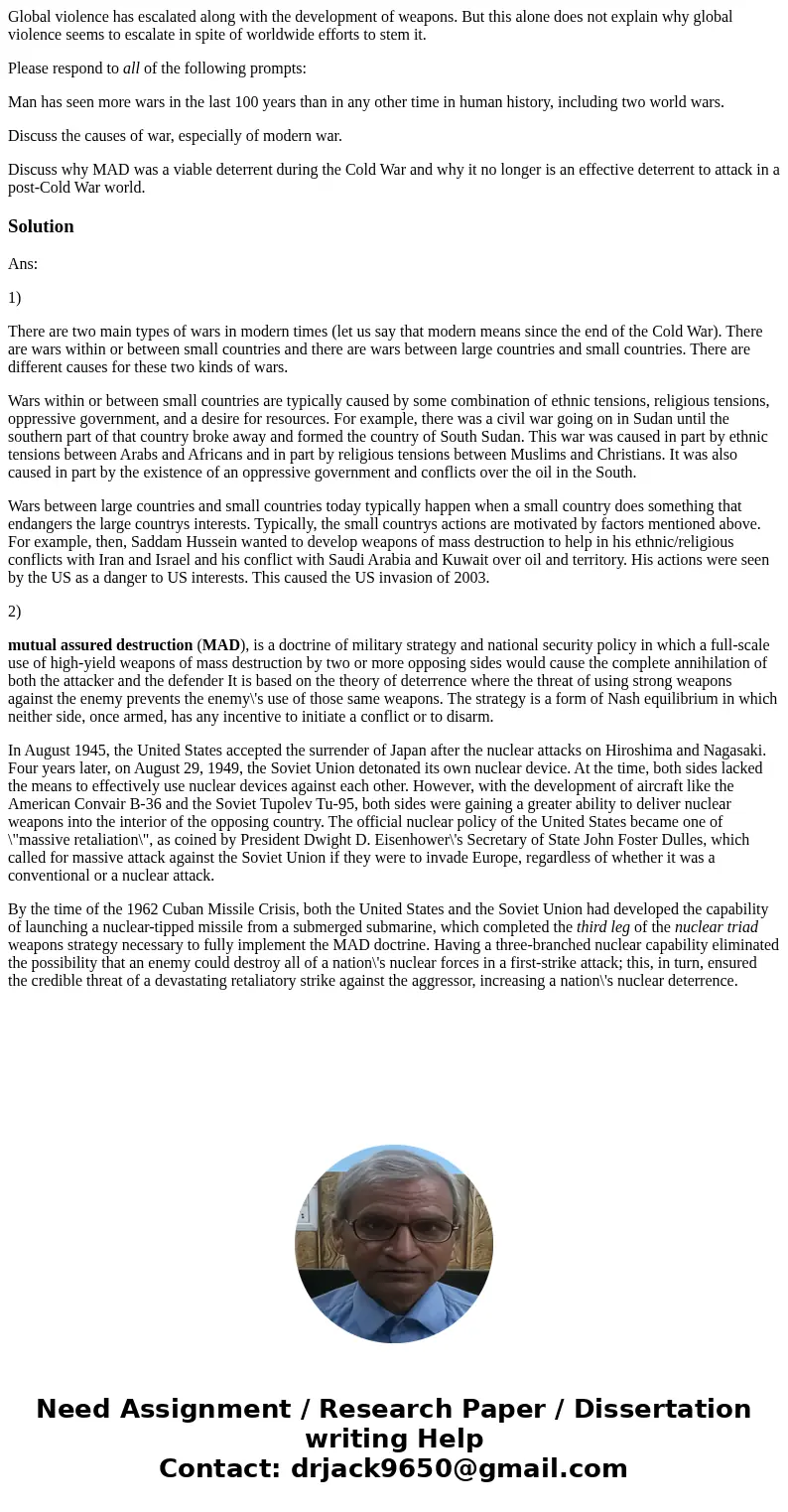Global violence has escalated along with the development of
Global violence has escalated along with the development of weapons. But this alone does not explain why global violence seems to escalate in spite of worldwide efforts to stem it.
Please respond to all of the following prompts:
Man has seen more wars in the last 100 years than in any other time in human history, including two world wars.
Discuss the causes of war, especially of modern war.
Discuss why MAD was a viable deterrent during the Cold War and why it no longer is an effective deterrent to attack in a post-Cold War world.
Solution
Ans:
1)
There are two main types of wars in modern times (let us say that modern means since the end of the Cold War). There are wars within or between small countries and there are wars between large countries and small countries. There are different causes for these two kinds of wars.
Wars within or between small countries are typically caused by some combination of ethnic tensions, religious tensions, oppressive government, and a desire for resources. For example, there was a civil war going on in Sudan until the southern part of that country broke away and formed the country of South Sudan. This war was caused in part by ethnic tensions between Arabs and Africans and in part by religious tensions between Muslims and Christians. It was also caused in part by the existence of an oppressive government and conflicts over the oil in the South.
Wars between large countries and small countries today typically happen when a small country does something that endangers the large countrys interests. Typically, the small countrys actions are motivated by factors mentioned above. For example, then, Saddam Hussein wanted to develop weapons of mass destruction to help in his ethnic/religious conflicts with Iran and Israel and his conflict with Saudi Arabia and Kuwait over oil and territory. His actions were seen by the US as a danger to US interests. This caused the US invasion of 2003.
2)
mutual assured destruction (MAD), is a doctrine of military strategy and national security policy in which a full-scale use of high-yield weapons of mass destruction by two or more opposing sides would cause the complete annihilation of both the attacker and the defender It is based on the theory of deterrence where the threat of using strong weapons against the enemy prevents the enemy\'s use of those same weapons. The strategy is a form of Nash equilibrium in which neither side, once armed, has any incentive to initiate a conflict or to disarm.
In August 1945, the United States accepted the surrender of Japan after the nuclear attacks on Hiroshima and Nagasaki. Four years later, on August 29, 1949, the Soviet Union detonated its own nuclear device. At the time, both sides lacked the means to effectively use nuclear devices against each other. However, with the development of aircraft like the American Convair B-36 and the Soviet Tupolev Tu-95, both sides were gaining a greater ability to deliver nuclear weapons into the interior of the opposing country. The official nuclear policy of the United States became one of \"massive retaliation\", as coined by President Dwight D. Eisenhower\'s Secretary of State John Foster Dulles, which called for massive attack against the Soviet Union if they were to invade Europe, regardless of whether it was a conventional or a nuclear attack.
By the time of the 1962 Cuban Missile Crisis, both the United States and the Soviet Union had developed the capability of launching a nuclear-tipped missile from a submerged submarine, which completed the third leg of the nuclear triad weapons strategy necessary to fully implement the MAD doctrine. Having a three-branched nuclear capability eliminated the possibility that an enemy could destroy all of a nation\'s nuclear forces in a first-strike attack; this, in turn, ensured the credible threat of a devastating retaliatory strike against the aggressor, increasing a nation\'s nuclear deterrence.

 Homework Sourse
Homework Sourse